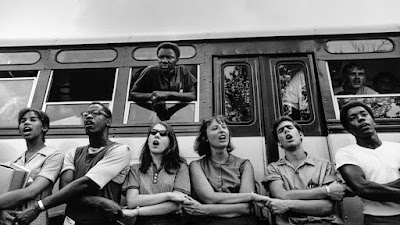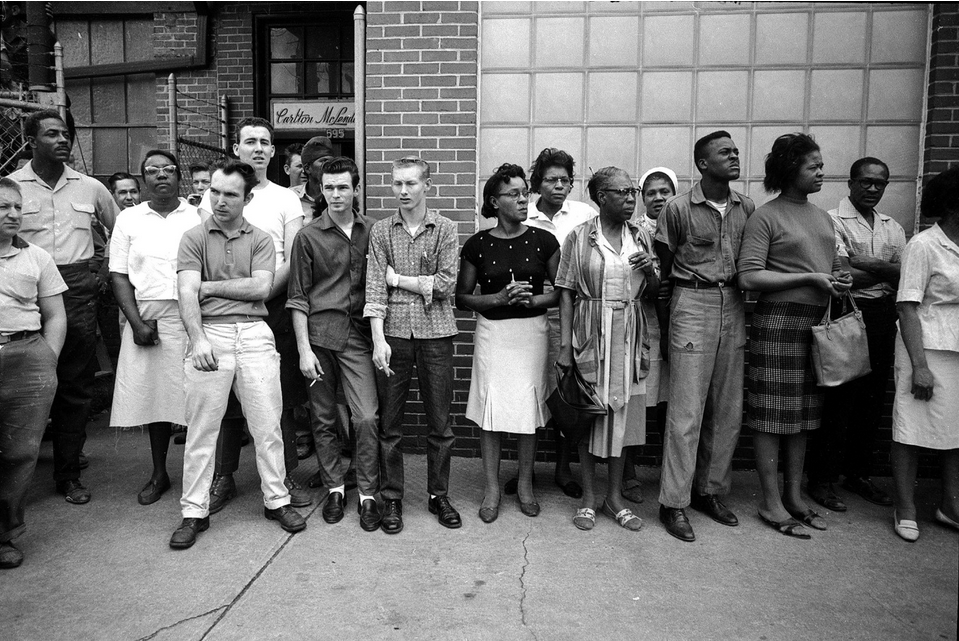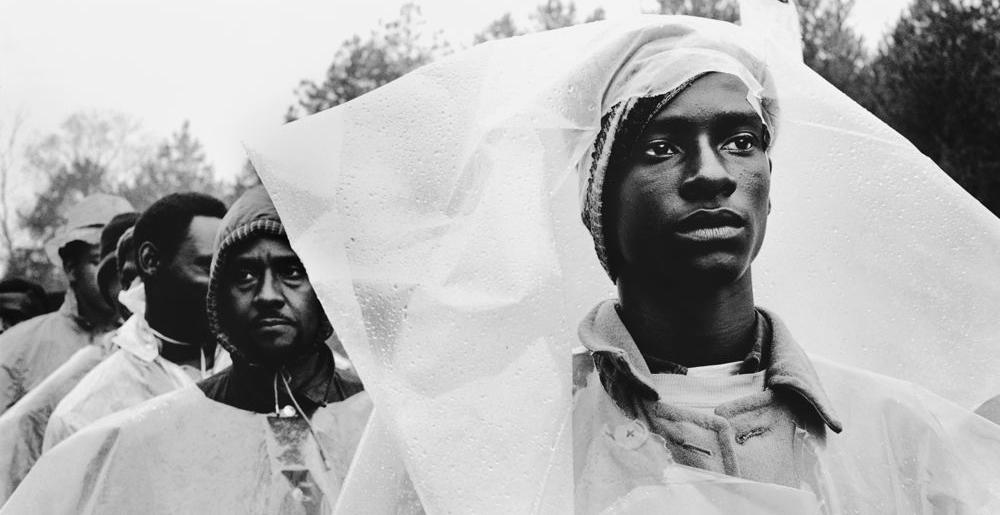Ernest C. Withers/©The Withers Trust
Sanitation Workers assemble in front of Clayborn Temple for a solidarity march, Memphis, TN, March 28, 1968
Via PASATIEMPO
The New Mexican's Weekly Magazine of Arts, Entertainment & Culture
Friday, October 4, 2013 5:00 am
James M. Keller
The photographer Ernest C. Withers had the good fortune to find himself at the right place at the right time, if Memphis in the 1950s and ’60s could possibly have been the right place and time for any African American. He must have been sometimes nervous as he navigated the byways of his native city and of the larger American South during that era of racial apartheid. Nonetheless, he showed a canny talent for observing trouble from close up without having it consume him personally. People let him get near, but he kept his photographer’s distance. This essential skill enabled to him to produce an extraordinary portfolio documenting the summit events of the civil-rights era.
On Friday, Oct. 4, an exhibition of his work opens at the Monroe Gallery of Photography, where it remains on display through Nov. 24. Sidney and Michelle Monroe have curated the show, which displays 40 photographs from an archive that runs well into the thousands. “In selecting the prints,” Sidney Monroe said, “we have tried to highlight images of the greatest significance from when Memphis was an epicenter of African-American life. Obviously, that means a number of images relating to civil rights, but Memphis was also a center of music at that time, and baseball was flourishing there. This was all part of the world Withers documented.”
Ernest C. Withers/ ©The Withers Trust
Login
Or, use your linked account:
Choose an online service.
- 1Online Subscription$9.95 for 30 daysUnlimited access to SantaFeNewMexican.com and PasatiempoMagazine.com. on your computer, smart phone and tablet.
- 2Total Access A: Online PLUS 7-day Print$12.95 for 30 daysUnlimted access to SantaFeNewMexican.com and PasatiempoMagazine.com. on your computer, smart phone and tablet. PLUS 7-Day home delivery of The New Mexican.
*Must reside within SFNM home delivery area. THESE RATES DO NOT APPLY IN PLACITAS, RIBERA, ILFIELD OR VILLNUEVA. PLEASE CALL 800-873-3372 FOR MORE INFORMATION.
- 3Total Access B: Online PLUS Weekend Print$12.95 for 30 daysUnlimted access to SantaFeNewMexican.com and PasatiempoMagazine.com. on your computer, smart phone and tablet. PLUS Weekend home delivery of The New Mexican.
*Must reside within SFNM home delivery area. THESE RATES DO NOT APPLY IN PLACITAS, RIBERA, ILFIELD OR VILLNUEVA. PLEASE CALL 800-873-3372 FOR MORE INFORMATION.
- 4Total Access C: Online PLUS Sunday Print$12.95 for 30 daysUnlimted access to SantaFeNewMexican.com and PasatiempoMagazine.com. on your computer, smart phone and tablet. PLUS Sunday home delivery of The New Mexican.
*Must reside within SFNM home delivery area. THESE RATES DO NOT APPLY IN PLACITAS, RIBERA, ILFIELD OR VILLNUEVA. PLEASE CALL 800-873-3372 FOR MORE INFORMATION.
Current print subscribers
Withers, who was born in 1922, maintained a studio on Beale Street, which had long been the main drag for the Memphis music industry; remember W.C. Handy’s “Beale Street Blues,” an early classic of its genre? By the 1950s, a new generation of music-makers was filling the hot and heavy Memphis air with traditional blues as well as the emerging sounds of soul, funk, and rock ’n’ roll. Images of many of these ground-breaking artists line the walls of the show — B.B. King, Howlin’ Wolf, Aretha Franklin, Elvis Presley, James Brown, and Isaac Hayes, among others. Baseball proved to be a parallel passion for Withers. He was already establishing his career when Jackie Robinson broke the sport’s color barrier in 1947, and he was there to document the decline of the Negro Leagues and the rise of African-American superstars on newly integrated diamonds: Larry Doby, Ernie Banks, Roy Campanella, Willie Mays, and others of their colleagues.
His work was not limited to famous names. “He had nine children,” Monroe said, “and he earned a good living by constantly hustling up work. When he was not out shooting a news event, he was hustling to shoot parties, weddings, anything that was going on locally.” The pictures of his music-star friends may excite us today, but when he was in a club, he was also snapping pictures of audience members, who bought their photo-portraits on the spot for a buck and a half.
Nonetheless, what made Withers irreplaceable was his ubiquity when the civil-rights movement crashed and banged through the American South. “He was kind of like the Woody Allen character Zelig,” Monroe said. “He was everywhere at once.” From his home in Memphis, Wither crisscrossed the South tracking the statesmen of the movement, including Medgar Evers, James Meredith, and, of course, Dr. Martin Luther King Jr. “He was renowned in these circles at that time, and he was trusted by the leaders of the movement and their families. He was friendly with Martin Luther King. Often Dr. King would specifically ask him to come document some event that was being planned. In that sense, he could be considered an insider in the movement. He was there at some of the most intimate moments. He was even given entrée to funerals; he photographed Medgar Evers after he was killed, and he took a photograph of King lying in his casket.”
Withers could document a great deal of civil-rights history without leaving his hometown. One of his most striking images depicts a solidarity march of sanitation workers in Memphis on March 28, 1968; it was to support these workers that Dr. King traveled to the city, where he would be gunned down a week later. The African-American demonstrators carry identical signs — perhaps a hundred of them — starkly declaring “I Am a Man” in what seems a river of humanity cresting behind a dam. Withers would also travel at the drop of a hat to place himself close to the action — for example, to witness King joining Rev. Ralph Abernathy in 1956 to ride a newly desegregated bus in Montgomery, Alabama; to observe the “Little Rock Nine” in Arkansas that same year; and to attend Evers’ funeral in Birmingham, Alabama, in 1963.
Withers constantly fed his black-and-white images to magazines including Life, Time, Newsweek, and Jet, and some of his pictures became iconic. Other photographers were also crowding around, to be sure, and they are well known to Monroe Gallery, which specializes in photojournalism. “Every one of those photographers was really one of a kind,” Monroe said. “Another was Charles Moore, a photographer based in Alabama, and he was very active when things started happening in Birmingham. He was white, but he had access because he was local. Often local photographers had first access to events; but when the national press would show up, things could get ugly.”
Unfortunately, Monroe said, “Withers’ story is a familiar one for photographers of the ’50s and ’60s. There was such a proliferation of magazines then that they could earn a good living being a news photographer. When the 1970s crept in, Americans were turning to TV at the expense of magazines. Life magazine folded. Everyone wanted color photos, which created issues for photographers and were harder to process for magazines. Withers was like many other important news photographers of his day; they were growing older, they had covered momentous moments in history, but they figured their work was basically done.” In his later years, Withers mostly busied himself photographing goings-on of essentially local interest in Memphis. Around the year 2000 there was a resurgent interest in civil-rights photography in general, and Withers accordingly enjoyed renewed acclaim. That year, a show of 125 of his photographs was exhibited at the Chrysler Museum of Art in Norfolk, Virginia, and then traveled to the Philadelphia Art Alliance; the show’s catalog, titled Pictures Tell the Story: Ernest C. Withers Reflections in History, has become a collector’s item. “Faced with increasing inquiries about his work, he went back to his negatives and started to make prints, though not a great deal. He was starting to be known again, but then he died in 2007.”
A curious coda to his career arrived in 2010, when it was reported that Withers had been an informant to the F.B.I. about the civil-rights scene in 1969 and 1970. “That stirred up a lot of concern. But from all we’ve been able to research, and from the accounts of his family, it becomes clear that a lot of people in the movement knew full well they were being watched.” Throughout his career, Withers was famous for attending civil-rights events with three cameras hanging from his neck. With one, he took pictures for the white press; with the second, for the black press; with the third, pictures for his own files. “He tried to remain friendly to the F.B.I. They would ask him for pictures, and he would have his three rolls of film. He knew what he was willing to give to them and what he was not. There is no evidence that the F.B.I. ever paid him, and no evidence that anything he provided them ever compromised anyone or anything. During his lifetime, Ernest Withers told people repeatedly that he actually avoided some meetings because he didn’t want to be privy to certain information that might be too sensitive. You could say he took the path of least resistance, and during those years that path actually allowed him to keep doing his work as he wanted. When you look at the work, the photographs speak for themselves.” ◀
details
▼ Ernest C. Withers: A Life’s Work
▼ Opening reception (Withers’ daughter Rosalind Withers is scheduled to attend) 5 p.m. Friday, Oct. 4; exhibit through Nov. 24
▼
Monroe Gallery of Photography, 112 Don Gaspar Ave., 505-992-0800
Ernest Withers:
William Edwin Jones pushes daughter Renee Andrewnetta Jones (8 months old, who grew up to become a doctor) during protest march on Main St., Memphis, Tennessee, August, 1961 (caption as written by Withers); image ©Withers Trust
Out for a stroll
The greatest examples of photojournalism document and convey a clear story with striking aesthetic elegance. Many of the photographs in Monroe Gallery’s Ernest C. Withers exhibition are masterly in that regard. From 1961 comes an image of a Memphis man pushing a baby girl in a stroller in the midday sun before the threatening gaze of four officers in a police car marked “Emergency Squad.” Like any responsible photojournalist, Withers does not consign the principals in this image to anonymity — at least not the principals who have his sympathy. The attached caption reads: “William Edwin Jones pushes daughter Renee Andrewnetta Jones (8 months old, who grew up to become a doctor) during protest march on Main St., Memphis, Tennessee, August, 1961.”
The frame is jam-packed with information, yet it is pleasingly structured, two commercial buildings in the background essentially bisecting the image vertically, with the father and daughter inhabiting the left side of the foreground and the policemen the right, even as the cruiser and the sidewalk cut a horizontal-diagonal swath across the frame. The police insignia on the car door identifies the place as Memphis. Around the neck of the man with the baby in a stroller hangs a large sign picturing … a man with a baby in a stroller. Its text proclaims, “Daddy, I Want To Be Free Too!!!!” The father and the four policemen train their eyes on one another. This unfairly stacked balance of power generates terrific tension, but the baby girl is focused elsewhere. She looks away from the scene, directing her eyes out of the frame directly to the camera, practically forcing the viewer to say, “What am I going to do about this?”
Sidney Monroe shared some of his thoughts about this photograph. “Images like this owe much to timing and, to some extent, luck — although it’s not just through luck that the photographer made such a picture. I imagine Withers, like many of the best photojournalists, would have said that you actually envision a picture before it happens. I’m picturing him walking around while people are dispersing after the event, and he notices the police car. I imagine him deciding to hang around the police car; there might be an interesting picture here. He’s having the foresight to wait. He may have already made other pictures, but then here comes this father, with the stroller, the baby, the sign. Withers is ready. It’s not luck so much as that Withers is ready for some interaction, and that is when he takes the picture. The greatest talent a photographer can have is patience. You can’t make a picture happen. You’re prepared for it when it does happen.”
— J.M.K.
Thank you for reading 10 free articles on our site. You can come back at the end of your 30-day period for another 10 free articles, or you can purchase a subscription at this time and continue to enjoy valuable local news and information. If you need help, please contact our office at 505-983-3303.












